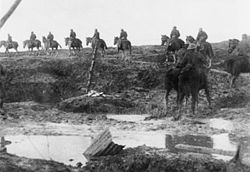Wikipedia:WikiProject Military history/News/November 2016/Op-ed
|
Our Pound of Flesh |

- By TomStar81
On November 18, 1916, the Battle of the Somme concluded with Allied action at the Battle of the Ancre. This battle, which would see several Imperial German Army units bled viciously, capped the bloodiest battle of World War I's Western Front. The end of major combat operations here for 1916 occurred in part due to the oncoming winter, when temperatures plunged and most military operations were suspended until spring due to the extreme difficulty of making men and machines work in sub-zero temperatures.
Several different but interconnected post-battle events merged to help make the Battle of the Somme the tipping point of the First World War, beginning with the unheard-of causality rates. By variable mathematical standards the Battle of the Somme left approximately 1.6 million soldiers from both sides killed or wounded, although that number varies based on historical analysis and record examination from the battle. At its onset the British Expeditionary Force, the primary arm of the British Empire engaged in the fighting, was inexperienced; by the battle's end they had not only gained battle experience but had come to master the art of industrialized warfare. For the German Empire, the operation's onset had seen several battle-hardened units exhausted, and with the removal and replacement of the German commander in September an initial decision was made to fall back to a new line of defenses. Although the withdrawal did not occur, the loss of the Imperial German Army's largest force on the Somme tipped the balance of the war toward the Allies. German losses could no longer be easily replaced in the aftermath of the Somme, while the Allied forces had expended over half a million men to move the trench lines a measly 6 miles. Air raids and tank assaults had assisted in this endeavor, but this was still a very high price to pay.
Logistically, the battle showed the problems with military resupply of arms and ammunition at the time. With poor roads and few rail lines to move the nearly 20,000 tons of weaponry and ammunition required to sustain a small fraction of the front, massive assaults could not be sustained for prolonged periods of time. As the Battle of the Somme drew to its conclusion, it became apparent that the roads and railroads near the front lines would need to expanded to accommodate the vehicular traffic and the men needed to move the supplies to the front lines quickly. This realization resulted in a shift of personnel from the battlefield to the logistical support teams, which drew down the number of military personnel manning the lines in a combat role -- not at the time a welcome development.
Somme's 1916 conclusion would not end the fighting in this area. In 1917, offensive operations resumed in the general vicinity, leading to military assaults intended to break through and crush German defensive lines, and new casualties. These casualties, however, are not generally counted toward the battle of the Somme specifically.
|


